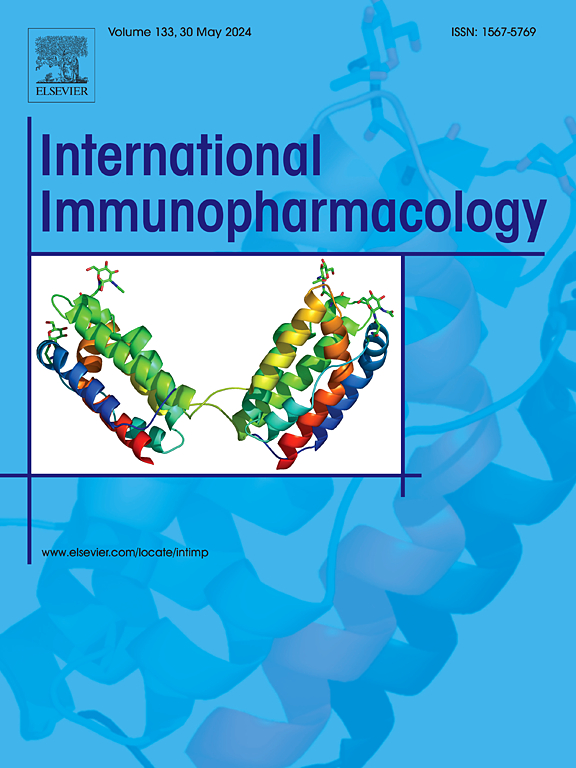利用奥昔康唑抑制经OSBP转运的STING并减轻Trex1 - / -小鼠的自身免疫病理
IF 4.7
2区 医学
Q2 IMMUNOLOGY
引用次数: 0
摘要
cGAS-STING通路是细胞内DNA先天免疫应答的关键组成部分,驱动I型干扰素(ifn)和促炎细胞因子的产生。然而,该通路的过度激活与各种自身免疫性和炎症性疾病有关。在本研究中,我们评估了fda批准的唑类抗真菌药物对cGAS-STING通路的调控作用。其中,奥昔康唑、咪康唑和伊曲康唑表现出明显的抑制作用,其中奥昔康唑的抑制作用最强。我们的数据表明,oxiconazole可以显著抑制合成DNA刺激或感染HSV-1的巨噬细胞和成纤维细胞I型IFN的产生和下游炎症反应。在机制上,奥昔康唑通过氧甾醇结合蛋白OSBP阻碍了STING的运输。利用单核增生李斯特菌感染模型和Trex1 - / -小鼠疾病模型,这两种模型都代表了过度cGAS-STING激活引起的体内炎症模型,我们证明了oxiconazole在单核增生李斯特菌感染模型中增强了细菌清除并减少了组织损伤。此外,oxiconazole治疗显著缓解Trex1−/−自身免疫性疾病小鼠模型中的多器官炎症和正常化异常IFN反应。这些发现突出了oxiconazole作为sting驱动的自身免疫性疾病和炎症性疾病的治疗药物的潜力。本文章由计算机程序翻译,如有差异,请以英文原文为准。

Repurposing oxiconazole to inhibit STING trafficking via OSBP and alleviate autoimmune pathology in Trex1−/− mice
The cGAS-STING pathway is a critical component of the innate immune response to cytosolic DNA, driving the production of type I interferons (IFNs) and pro-inflammatory cytokines. However, excessive activation of this pathway is associated with various autoimmune and inflammatory diseases. In this study, we evaluated the regulation of FDA-approved azole antifungal drugs on the cGAS-STING pathway. Among these drugs, oxiconazole, miconazole, and itraconazole demonstrate significant inhibitory effects, with oxiconazole showing the strongest activity. Our data demonstrates that oxiconazole significantly suppressed type I IFN production and downstream inflammatory responses in macrophages and fibroblasts stimulated with synthetic DNA or infected with HSV-1. Mechanistically, oxiconazole hindered STING trafficking via oxysterol-binding protein OSBP. Using the Listeria monocytogenes infection model and the Trex1−/− mouse disease model, both representing in vivo models of inflammation driven by excessive cGAS-STING activation, we demonstrate that oxiconazole enhanced bacterial clearance and reduced tissue damage in the Listeria monocytogenes infection model. Moreover, oxiconazole treatment significantly alleviated multi-organ inflammation and normalized aberrant IFN responses in the Trex1−/− autoimmune disease mouse model. These findings highlight the potential of oxiconazole as a promising therapeutic agent for STING-driven autoimmune and inflammatory diseases.
求助全文
通过发布文献求助,成功后即可免费获取论文全文。
去求助
来源期刊
CiteScore
8.40
自引率
3.60%
发文量
935
审稿时长
53 days
期刊介绍:
International Immunopharmacology is the primary vehicle for the publication of original research papers pertinent to the overlapping areas of immunology, pharmacology, cytokine biology, immunotherapy, immunopathology and immunotoxicology. Review articles that encompass these subjects are also welcome.
The subject material appropriate for submission includes:
• Clinical studies employing immunotherapy of any type including the use of: bacterial and chemical agents; thymic hormones, interferon, lymphokines, etc., in transplantation and diseases such as cancer, immunodeficiency, chronic infection and allergic, inflammatory or autoimmune disorders.
• Studies on the mechanisms of action of these agents for specific parameters of immune competence as well as the overall clinical state.
• Pre-clinical animal studies and in vitro studies on mechanisms of action with immunopotentiators, immunomodulators, immunoadjuvants and other pharmacological agents active on cells participating in immune or allergic responses.
• Pharmacological compounds, microbial products and toxicological agents that affect the lymphoid system, and their mechanisms of action.
• Agents that activate genes or modify transcription and translation within the immune response.
• Substances activated, generated, or released through immunologic or related pathways that are pharmacologically active.
• Production, function and regulation of cytokines and their receptors.
• Classical pharmacological studies on the effects of chemokines and bioactive factors released during immunological reactions.

 求助内容:
求助内容: 应助结果提醒方式:
应助结果提醒方式:


